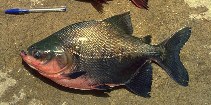Colossoma macropomum (Cuvier, 1816)
Cachama
Uploaden van uw Foto's en video's
Pictures | Google afbeeldingColossoma macropomum
Picture by Lovshin, L.
Pictures | Google afbeeldingColossoma macropomum
Picture by Lovshin, L.
Bolivia country information
Common names:
Pacu
Occurrence: native
Salinity: freshwater
Abundance: | Ref:
Importance: | Ref:
Aquaculture: | Ref:
Regulations: | Ref:
Uses: no uses
Comments: Trinidad, Rio Mamore, MNHN 1989-1372
National Checklist:
Country Information: https://www.cia.gov/library/publications/resources/the-world-factbook/geos/bl.html
National Fisheries Authority:
Occurrences: Occurrences Point map
Main Ref: Jégu, M., 2003
National Database:
Occurrence: native
Salinity: freshwater
Abundance: | Ref:
Importance: | Ref:
Aquaculture: | Ref:
Regulations: | Ref:
Uses: no uses
Comments: Trinidad, Rio Mamore, MNHN 1989-1372
National Checklist:
Country Information: https://www.cia.gov/library/publications/resources/the-world-factbook/geos/bl.html
National Fisheries Authority:
Occurrences: Occurrences Point map
Main Ref: Jégu, M., 2003
National Database:
Common names from other countries
Classificatie / Names Lokale namen | Synoniemen | Catalog of Fishes(Genus, Soort(en)) | ITIS | CoL | WoRMS | Cloffa
> Characiformes (Characins) > Serrasalmidae (Piranhas and pacus) > Colossomatinae
Etymology: Colossoma: Greek, kolos = short, truncated + Greek, soma = body (Ref. 45335).
More on author: Cuvier.
Etymology: Colossoma: Greek, kolos = short, truncated + Greek, soma = body (Ref. 45335).
More on author: Cuvier.
Issue
See Machado-Allison 1982: 42, Géry 1986: 97 and Machado-Allison 1986: 2 for detailed description. See Goulding & Carvalho 1982 and Araujo Lima & Goulding 1997 for general biology and management. See Loubens & Panfili 1997 for growth biology.
Environment: milieu / climate zone / depth range / distribution range Ecologie
; zoet water benthopelagisch; pH range: 5.0 - 7.8; dH range: ? - 20; potamodroom (Ref. 51243); diepte 5 - ? m. Tropical; 22°C - 28°C (Ref. 1672); 15°S - 35°S
Verspreiding Landen | FAO regio's | Ecosystemen | Voorkomen | Point map | Introducties | Faunafri
South America: Amazon and Orinoco basins as wild form; pisciculture form largely distributed in South America.
Lengte bij maturiteit / Grootte / Gewicht / Leeftijd
Maturity: Lm ?, range 24 - ? cm
Max length : 108 cm TL mannelijk / geslacht onbekend; (Ref. 40637); common length : 70.0 cm TL mannelijk / geslacht onbekend; (Ref. 9987); max. gepubliceerd gewicht: 40.0 kg (Ref. 72380)
Max length : 108 cm TL mannelijk / geslacht onbekend; (Ref. 40637); common length : 70.0 cm TL mannelijk / geslacht onbekend; (Ref. 9987); max. gepubliceerd gewicht: 40.0 kg (Ref. 72380)
This species is usually solitary. Adults stay in flooded forests during first 5 months of flooding and consume but fruits and grains. Young and juveniles live in black waters of flood plains until their sexual maturity. Feeds on zooplankton, insects, snails and decaying plants (Ref. 32894). Used in aquaculture because it can live in mineral poor waters and is very resistant to diseases. Marketed fresh and frozen (Ref. 9987).
Levenscyclus en paargedrag Maturiteit | Voortplanting | Paaien | Eieren | Fecunditeit | Larven
Hoofdreferentie
Upload your references | Referenties | Coördinator | Medewerkers
Géry, J., 1977. Characoids of the world. Neptune City ; Reigate : T.F.H. [etc.]; 672 p. : ill. (chiefly col.) ; 23 cm. (Ref. 598)
Status op de Rode Lijst van het IUCN (Ref. 130435: Version 2024-2)
Gevoelig (NT) (Near Threatened); Date assessed: 17 December 2020
Gevaar voor de mens
Traumatogenic
Gebruik door de mens
Visserij: van minder commercieel belang; Aquacultuur: commercieel; sportvis: ja; Aquarium: Publieke aquaria
FAO(Aquaculture systems: productie; visserij: productie; publication : search) | FishSource |
Meer informatie
Population dynamics
Groeiparameters
Max. ages / sizes
Length-weight rel.
Length-length rel.
Lengtefrequenties
Massaconversie
Rekrutering
Abundantie
Groeiparameters
Max. ages / sizes
Length-weight rel.
Length-length rel.
Lengtefrequenties
Massaconversie
Rekrutering
Abundantie
Life cycle
Voortplanting
Maturiteit
Fecunditeit
Paaien
Spawning aggregations
Eieren
Ontwikkeling van de eieren
Larven
Larvale populatiedynamiek
Voortplanting
Maturiteit
Fecunditeit
Paaien
Spawning aggregations
Eieren
Ontwikkeling van de eieren
Larven
Larvale populatiedynamiek
Anatomy
Kieuwoppervlak
Brain
Otolith
Kieuwoppervlak
Brain
Otolith
Physiology
Body composition
Nutrients
Zuurstofverbruik
Zwemtype
Zwemsnelheid
Visual pigments
Fish sound
Diseases & Parasites
Toxicity (LC50s)
Body composition
Nutrients
Zuurstofverbruik
Zwemtype
Zwemsnelheid
Visual pigments
Fish sound
Diseases & Parasites
Toxicity (LC50s)
Human related
Aquaculture systems
Aquacultuurprofielen
Kweeklijnen
Ciguatera cases
Stamps, coins, misc.
Aquaculture systems
Aquacultuurprofielen
Kweeklijnen
Ciguatera cases
Stamps, coins, misc.
Tools
E-boek | Veldgids | Lengtefrequentie Tool | Levenscyclus tool | Verspreidingskaart | Classification Tree
| Catch-MSY |
Speciale rapporten
Bekijk gegevens voor het houden in een aquarium | Bekijk Fact Sheets voor de soort | Bekijk Aquacultuur Fact Sheets
Download XML
Internetbronnen
Exoten/Invasieve soorten database | Aquatic Commons | BHL | Cloffa | Websites from users | Bekijk FishWatcher | CISTI | Catalog of Fishes(Genus, Soort(en)) | DiscoverLife | ECOTOX | Faunafri | Fishtrace | GenBank(genoom, nucleotide) | GloBI | GOBASE | | Google Books | Google Scholar | Google | IGFA World Record | MitoFish | Nationale databanken | Otolith Atlas of Taiwan Fishes | Publieke aquaria | PubMed | Reef Life Survey | Scirus | SeaLifeBase | Tree of Life | Wikipedia(ga naar, zoek) | World Records Freshwater Fishing | Zoological Record
Estimates based on models
Fylogenetische diversiteitsindex (Ref. 82804): PD50 = 1.0000 [Uniqueness, from 0.5 = low to 2.0 = high].
Bayesian length-weight: a=0.02239 (0.01185 - 0.04230), b=2.99 (2.82 - 3.16), in cm Total Length, based on LWR estimates for this species & (Sub)family-body (Ref. 93245).
Trofisch niveau (Ref. 69278): 2.0 ±0.0 se; based on diet studies.
Weerstandsvermogen (Ref. 120179): Gemiddeld, minimale populatieverdubbelingstijd 1,4-4,4 jaar (K=0.23; Fec=7,000-300,000).
Fishing Vulnerability (Ref. 59153): Moderate to high vulnerability (47 of 100).




